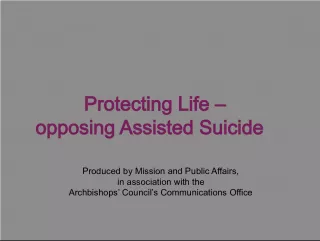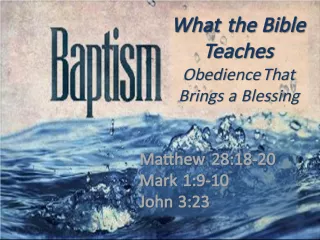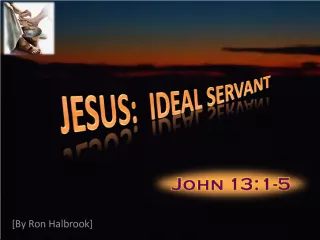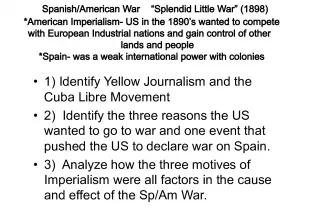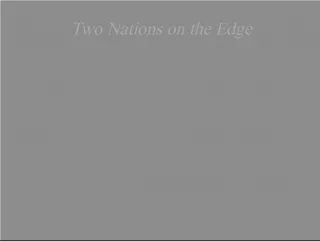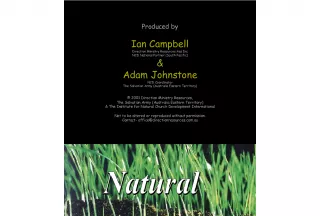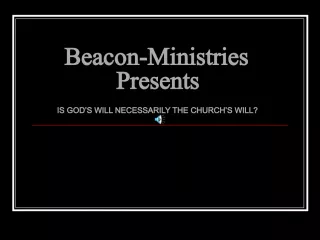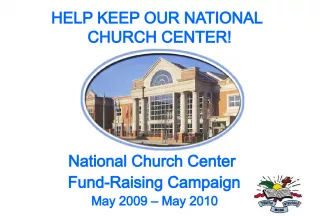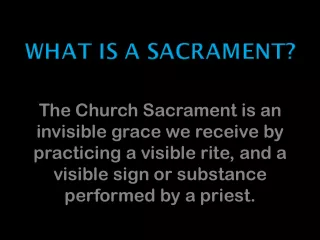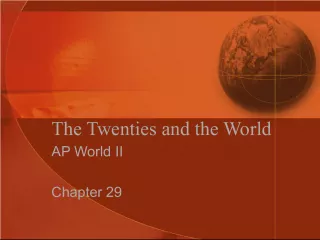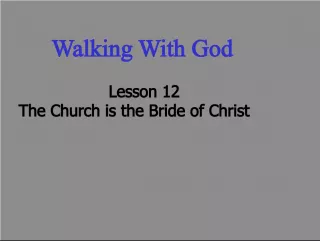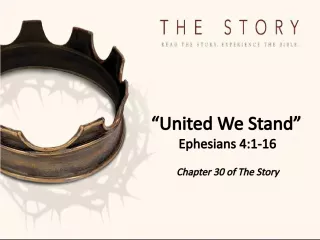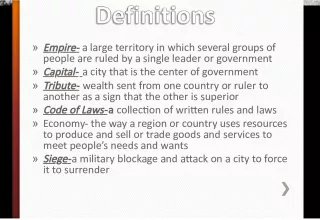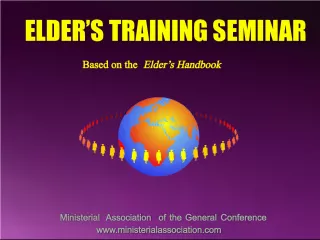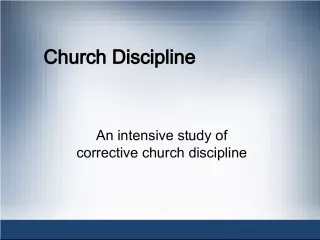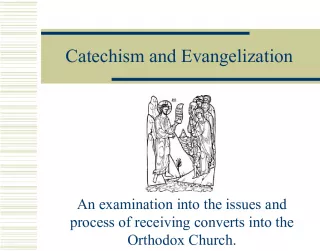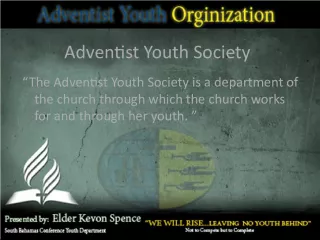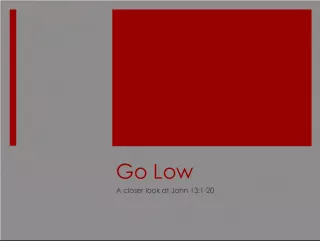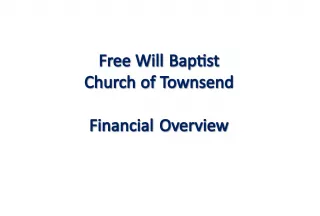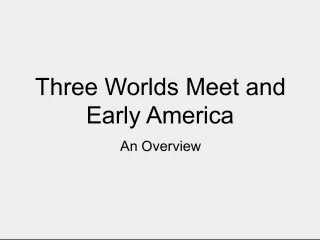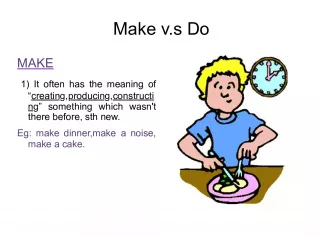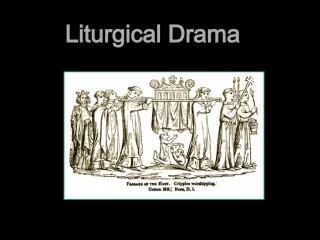Go and Make Disciples of all Nations: The Early Church


This book tells the story of the early church, as described in the book of Acts. It begins with Jesus' Resurrection and his forty days on earth before his
- Uploaded on | 1 Views
-
 stacy
stacy
About Go and Make Disciples of all Nations: The Early Church
PowerPoint presentation about 'Go and Make Disciples of all Nations: The Early Church'. This presentation describes the topic on This book tells the story of the early church, as described in the book of Acts. It begins with Jesus' Resurrection and his forty days on earth before his. The key topics included in this slideshow are . Download this presentation absolutely free.
Presentation Transcript
Slide1“Go and Make Disciples of allNations”
Slide2The Story of the Early Church• Jesus remained on earth for forty days after his Resurrection. • When the time came for his Ascension into Heaven, he gathered his Apostles together and told them to await the coming of the Holy Spirit. • “You shall receive power from the Holy Spirit; you shall be my witness in all Judea and Samaria and to the end of the earth.” (Acts 1:8)
Slide3HE WILL UNITE THE TRIBES…..• These places represent the ancient kingdom of David: • Jerusalem was David’s capital city. • Judea was the tribal territory of David that surrounded Jerusalem. • Samaria was the land north where the rest of the tribes of Israel were located. • The ends of the earth represent the gentile nations.
Slide4Making Disciples…• When Jesus established the Apostles as shepherds of the Church, he appointed them as symbolic rules of the twelve tribes. • After the Ascension, Mary, the Mother of Jesus along with Peter and the apostles stayed in the upper room to prepare for the Holy Spirit. • Matthias is chosen as the 12 th apostle to replace Judas.
Slide5Pentecost• Ten days after Christ’s Ascension into Heaven, the Apostles together with Mary and the other disciples received the Holy Spirit. • Tongues of fire appeared over their heads and they began to speak in other tongues. Their transformation was immediate. • The day of Pentecost marks the beginning of the Church’s ministry in the world.
Slide6The Holy Spirit Works in the ChurchToday. • Through the Pope and the Bishops (Magisterium). – Their role to govern, sanctify, and proclaim the Gospel. • In Sacred Scripture – To proclaim the Gospel of Jesus. • In the Sacraments – In each of the Sacraments, the Church allows for the spiritual growth and healing of all members.
Slide7The Holy Spirit allows the Church toGrow • In the gifts of the Holy Spirit – Wisdom, understanding, counsel, fortitude, knowledge, piety and fear of the Lord • The fruits of the Holy Spirit – Charity, Joy, Peace, Patience, Benignity, Goodness, Longanimity, Mildness, Faith, Modesty, Continency, Chastity. • Through special graces - charisms
Slide8St. Peter• While Christ was still on earth, he made it clear that St. Peter would possess authority over the Church. • It was St. Peter who announced a need to replace Judas. • It was St. Peter who spoke for the apostles at Pentecost. • It was St. Peter who performed the first miracle (the healing of a crippled man). • It was St. Peter who spoke on behalf of the apostles when they were arrested by the Jewish officials.
Slide9St. Peter• In the Old Testament kingdom of David, the King appointed a prime minister. In the New Testament, Christ the King appointed one of the Twelve to have primacy over the others. • The sign of the authority of Peter and the Papacy is the crossed keys (the keys to the kingdom). • The pope is the “Vicar of Christ” meaning “in the person of”.
Slide10St. Peter• The role of the papacy has evolved through the centuries as the political and social circumstances surrounding the Church have changed. What has remained constant is the role of the papacy as the Church’s highest moral and doctrinal authority. • “Rock” foundation. • Keys – leader of the Church • The power of binding and loosing
Slide11The Apostles• St. Paul – Although not one of the Twelve, he is one of the most significant figures in the early Church. He was among the first to preach to the Gentiles. He was the author of several books in the New Testament. He converted a large number of people in the Roman Empire. He founded new Christian Churches.
Slide12The Apostles• St. Philip – Ethiopia was considered to be the far end of the Empire. He baptized the first Gentile into Christianity without first becoming a Jew. • The Council of Jerusalem – (AD51) – Gentiles would not be required to ritually convert to Judaism before becoming a Christian. The Church separates itself from the Temple.
Slide13The Apostles• St. Peter – Crucified up-side down in Rome. (AD64) • St. James the Greater – Beheaded in AD44 by Herod Agrippa. The first apostle to die for Jesus. • St. John the Beloved – The Book of Revelation. Gave a vision of the heavenly liturgy and the trials the early Christians would suffer. • St. Andrew – called the apostle to the Greeks. Crucified on a “X” shaped cross.
Slide14The Apostles• St. Philip – The Gospels do not mention his missionary journeys but it is said that he was with Jesus through his public ministry. • St. Bartholomew (Nathaniel) – Tradition states that he preached in Persia. Another tradition states that he was martyred by being flayed alive.
Slide15The Apostles• St. Matthew – “the tax collector”. Tradition says that he ministered directly to the Jews. His gospel is written in Aramaic which was the language of the Jewish people. • St. Thomas – Tradition says that he preached in present day Iran and Turkmenistan. It is suggested that he founded the church in India and was martyred there.
Slide16The Apostles• St. James the Lesser – Became the head of the Church of Jerusalem. Called “brother” of our Lord, a title given to a close relative. He was martyred in AD 62 by being stoned to death. • St. Jude (Judas/Thaddeus) – Preached in Judea and Samaria as well as Syria, Mesopotamia and Libya. He is the patron of the Armenian Church. Said to have been martyred in Beirut.
Slide17The Apostles• St. Simon – “Simon the Zealot/Simon Peter” Tradition says that he preached in Egypt and Northern Africa. It is said that he was martyred by being sawn in pieces.
Slide18Names and Images of the ChurchPages 52 – 65 in the textbook • The Mystical Body of Christ • The Bride of Christ • The Family of God • The People of God • The Kingdom of God
